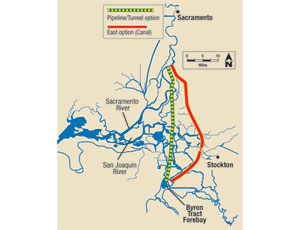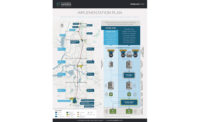On Dec. 15, the California Natural Resources Agency, U.S. Dept. of the Interior and four other agencies released the Bay Delta Conservation Plan, calling for construction of a $13-billion tunnel to bring water from northern California to the Central Valley.
The multi-agency study looked at alternatives to the 100-year-old delta levee system that would preserve water shipments to the southern part of the state without damaging the delta ecosystem and killing fish. Studies point to the intake pumps in the San Francisco Bay Area as a primary source of large-scale fish mortality in the region.
“The current infrastructure and operational approach for managing water resources in the bay delta is unsustainable,” concluded the report, which referenced two earlier studies: Gov. Arnold Schwarzenegger’s “Delta Vision” task-force report and the Public Policy Institute of California’s 2008 “Comparing Futures for the Sacramento-San Joaquin Delta” study.
The report concluded that continuing current operations would cost $550 million to $1.86 billion per year and result in the highest survival rate for fish populations. A dual conveyance through the delta and through a peripheral canal would cost between $250 million and $1.25 billion annually and increase fish populations by about 10%.
A peripheral canal, which could take the form of dual bore tunnels, combined with $3.3 billion to restore 15,000 acres of delta habitat, was seen as the lowest cost alternative, at $250 million to $850 million a year to meet the dual goals of environmental stability and water-supply reliability.
The design of a canal system was still very rough, but initial estimates were based on specific components: 33-ft-dia tunnels, 74-ft apart, 150 ft underground, with capacity of up to 15,000 cu ft per second (cfs) capacity.
The tunnels would start south of Sacramento with five 3,000-cfs, 1,700-ft-long screened intake structures on the Sacramento River and end some 70 miles south in the Byron Tract Forebay.
The report recommended the tunnel as the safest way to transport water to the Central Valley and the easiest process to permit. The project would be paid for by state and federal water purveyors, who would pass the costs onto water users.
The update calls for an environmental review in 2011, followed by the permitting process. Construction could begin in 2013 and be completed by 2022.




Post a comment to this article
Report Abusive Comment